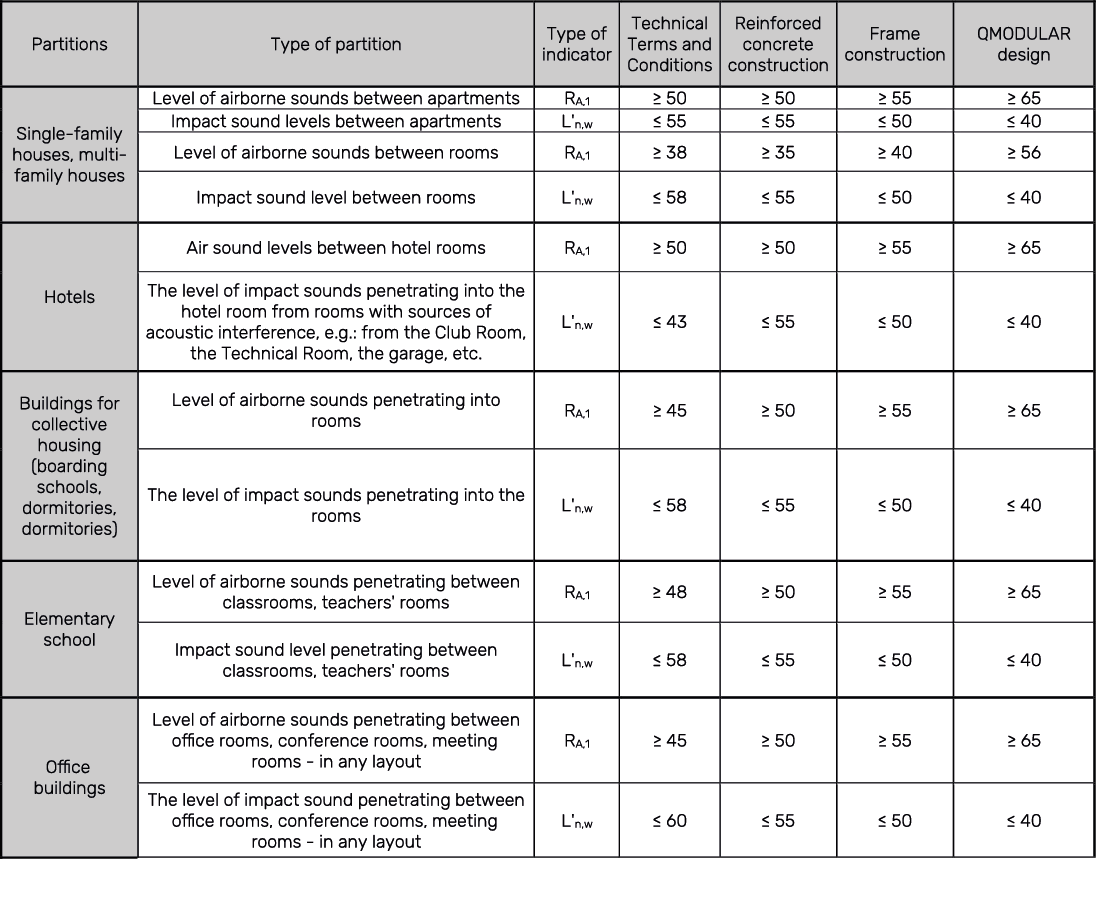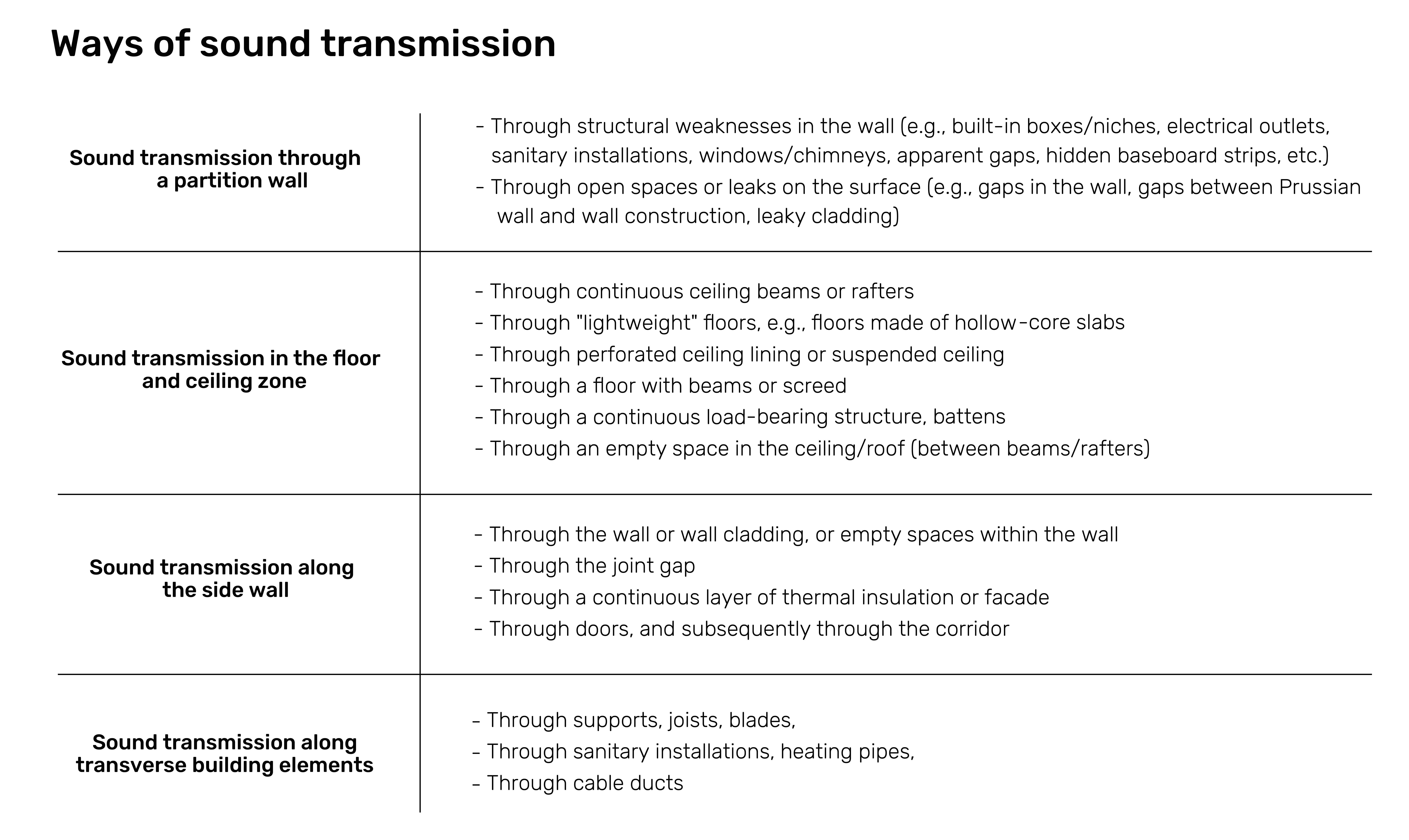In an era of increasing popularity of sustainable construction, modular technology is gaining significance. We have analyzed advanced solutions in the field of sound insulation, comparing them with conventional techniques to understand how a modern approach to modular construction can surpass acoustic standards.
During the design and construction phases of buildings, it is necessary to ensure adequate acoustic comfort for users of the facility. In addition, it is important to meet standards for noise emissions into the environment. The implementation of comprehensive solutions to secure the acoustics of a building mainly includes:
– insulation of indoor spaces from external noise,
– reduction of sound transmission between building interiors,
– preventing sound from escaping to the outside, especially in the case of intense noise emissions inside the building (e.g., associated with industrial noise, club events, etc.),
– creating an optimal “acoustic climate” indoors.
| Basic acoustic threats to a building | |||
| Internal noise (e.g., traffic noise) |
Internal noise (generated by building occupants) | Noise from technical equipment (e.g., from installations) | Reverberation noise |
| Airborne and material sounds | Airborne sounds | Airborne and material sounds | Airborne sounds |
| Impact sounds (e.g., footsteps) | |||
| Actions in the field of acoustic protection | |||||
| Acoustic isolation from airborne sounds: | Vibration isolations, expansions, flexible connections: | Acoustic isolation from airborne sounds: | Impact sound insulation: | Airborne sound insulation and vibration isolation | Sound control, reducing the sound level in protected rooms: |
| -External walls
-Roofs -Windows -External doors |
-For the entire structure
-For individual building elements |
-Partition walls
-Ceilings -Doors |
-Ceiling
-Stairs |
-Ventilation system installation
-Sanitary installations -Technical equipment elements of the building (e.g., elevators) |
-Hangars
-Offices -Corridors -Conference rooms, etc. |
Source: Knauf
The human ear is able to perceive sound waves in the frequency range from about 16 Hz to 16-20 kHz. Below 16 Hz (infrasound), sound waves are perceived as vibrations, while frequencies above 20 kHz (ultrasound) are usually not heard by humans. The range of audible sound can vary depending on the individual predisposition of the listener, and also decreases with age and the decline in the condition of the auditory system. Sound perception is a subjective experience, depending not only on volume, but also on frequency.
Insulation of building components
To effectively protect against sound transmission, it is recommended to use building partitions with high sound insulation. A key role is played by the precise execution and installation of these partitions. When designing and installing insulating partitions, it is worth paying attention to the following:
Airtightness of the partition and connections to lateral elements: Ensuring high sound insulation requires eliminating all leaks on the surface of the partition and at its connections to lateral elements. Leaks act as air channels, allowing sound to pass between rooms.
Lightweight building elements: For lightweight building elements, it is important to seal the edges of the panels and seal the joints with adjacent elements, such as with acoustic tape. It is especially worth monitoring joints with elements prone to cracking during use.
Retrofitting of masonry walls: To improve the sound insulation of masonry walls, it is recommended that the existing wall be plastered before installing exterior cladding or that joints be carefully closed to prevent loss of sound insulation of the partition.
Longitudinal sound transmission: When analyzing the effectiveness of a partition in noise protection, it is important to consider the longitudinal transmission of sound through bordering lateral building elements. These elements can transmit sound to adjacent rooms, which affects the overall sound insulation performance of the partition.
The table below can serve as a checklist for acoustic design; it lists the most common sound transmission paths.
Ways of sound transmission
| Sound transmission through a partition wall | – Through structural weaknesses in the wall (e.g., built-in boxes/niches, electrical outlets, sanitary installations, windows/chimneys, apparent gaps, hidden baseboard strips, etc.)
– Through open spaces or leaks on the surface (e.g., gaps in the wall, gaps between Prussian wall and wall construction, leaky cladding) |
| Sound transmission in the floor and ceiling zone | – Through continuous ceiling beams or rafters
– Through “lightweight” floors, e.g., floors made of hollow-core slabs – Through perforated ceiling lining or suspended ceiling – Through a floor with beams or screed – Through a continuous load-bearing structure, battens – Through an empty space in the ceiling/roof (between beams/rafters) |
| Sound transmission along the side wall | – Through the wall or wall cladding, or empty spaces within the wall
– Through the joint gap – Through a continuous layer of thermal insulation or facade – Through doors, and subsequently through the corridor |
| Sound transmission along transverse building elements | – Through supports, joists, blades,
– Through sanitary installations, heating pipes, – Through cable ducts |
Source: Knauf
Sound insulation requirements
Annex No. 1 to the Ordinance of the Minister of Infrastructure of November 14, 2017, concerning technical conditions of buildings and their location, includes the specified Polish standards cited in this document. Among them are the standards:
PN-B-02151-02:1987 , “Building acoustics – Noise protection of rooms in buildings – Permissible values of sound level in rooms”.
PN-B-02151-3:2015 “Building acoustics – Protection against noise in buildings – Requirements for sound insulation of building partitions and building elements”.
According to the guidelines in the new PN-B-02151-3:2015-10 standard, the calculation of sound insulation of the building envelope is presented differently than in previous versions. In this case, it is necessary to take into account the following data:
– the authoritative external noise level at a given partition (LA,zew );
– standard reference level (LA,wew );
– acoustic absorption of the room in the mid-frequency band f=500Hz, without the presence of users and equipment (A);
– the projected area of the surface of an exterior partition on the plane of the facade or roof as seen from the side of the room;
– these values are necessary to accurately calculate the sound insulation of the building envelope, instead of relying on table readings, as in previous versions of the standard.
Comparative table of insulation of the building against the requirements of technical conditions, traditional technology and QMODULAR technology, broken down by specific partitions.
The higher the value of the airborne sound insulation index R’A1 , the better the sound insulation of the separating building element. The lower the value of the impact sound insulation index L’n,w the better the sound insulation of the separating building element.
| Partitions | Type of partition | Type of indicator | Technical Terms and Conditions | Reinforced concrete construction | Frame construction | Qmodular design |
| Single-family houses, multi-family houses | Level of airborne sounds between apartments | RA,1 | ≥ 50 | ≥ 50 | ≥ 55 | ≥ 65 |
| Impact sound levels between apartments | L’n,w | ≤ 55 | ≤ 55 | ≤ 50 | ≤ 40 | |
| Level of airborne sounds between rooms | RA,1 | ≥ 38 | ≥ 35 | ≥ 40 | ≥ 56 | |
| Impact sound level between rooms | L’n,w | ≤ 58 | ≤ 55 | ≤ 50 | ≤ 40 | |
| Hotels | Air sound levels between hotel rooms | RA,1 | ≥ 50 | ≥ 50 | ≥ 55 | ≥ 65 |
| The level of impact sounds penetrating into the hotel room from rooms with sources of acoustic interference, e.g.: from the Club Room, the Technical Room, the garage, etc. | L’n,w | ≤ 43 | ≤ 55 | ≤ 50 | ≤ 40 | |
| Buildings for collective housing (boarding schools, dormitories) | Level of airborne sounds penetrating into rooms | RA,1 | ≥ 45 | ≥ 50 | ≥ 55 | ≥ 65 |
| The level of impact sounds penetrating into the rooms | L’n,w | ≤ 58 | ≤ 55 | ≤ 50 | ≤ 40 | |
| Elementary school | Level of airborne sounds penetrating between classrooms, teachers’ rooms | RA,1 | ≥ 48 | ≥ 50 | ≥ 55 | ≥ 65 |
| Impact sound level penetrating between classrooms, teachers’ rooms | L’n,w | ≤ 58 | ≤ 55 | ≤ 50 | ≤ 40 | |
| Office buildings | Level of airborne sounds penetrating between office rooms, conference rooms, meeting rooms – in any layout | RA,1 | ≥ 45 | ≥ 50 | ≥ 55 | ≥ 65 |
| The level of impact sound penetrating between office rooms, conference rooms, meeting rooms – in any layout | L’n,w | ≤ 60 | ≤ 55 | ≤ 50 | ≤ 40 |
More about modular technology.















